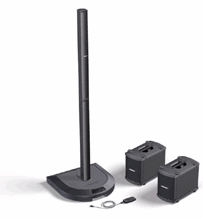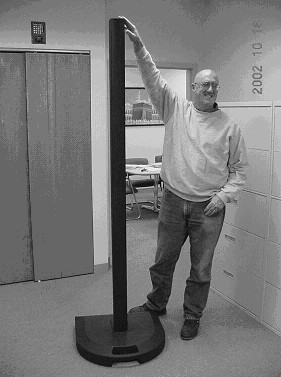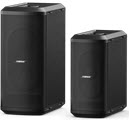L1® Classic
The L1 Classic
"The L1® Classic" or simply "The Classic"
This is the name now used to describe the original L1® Model in the Bose® Personalized Amplification System™ family of products.
Introduced in 2003, this remained in production until 2007 when the L1 Model I was introduced. Visually and acoustically almost identical, the main differences were:
- See PS1 Power Stand Connections for a detailed view of the following
- On the right side of the input/output panel, there are inputs for
- All Amps In
- Amp 1 In
- Amp 2 In
- Amp 3 In
- There are outputs
- Amp 1 Out
- Amp 2 Out
- Amp 3 Out (used for B1 Bass Modules)
- Features above support accessing the three amplifiers separately. One application is to drive up to six B1 Bass Modules from a single Power Stand. See: Classic Extended Bass Package
- On the right side of the input/output panel, there are inputs for
- Units that were shipped with the Version 2 Presets have a blue ring around the Amp 3 output (for B1 Bass Modules).
- Identified by orange labels and L1™ logo
- Simpler output panel (dropped Amp 1 out, Amp 2 out)
- RoHS compliant.
Different Models
How to Tell the Difference Between Bose Portable PA Models
This is how to tell which L1®, S1 Pro, or F1 unit you have.
| 2023 - Present | S1 Pro+ (optional wireless transmitters), Remote Control and ToneMatch Presets with Bose App | |||
| 2020 - Present | L1 Pro8, L1 Pro16, L1 Pro32, Remote Control and ToneMatch Presets with Bose App | |||
| 2020 - Present | Sub module for L1 Pro32 | |||
| 2018 - Present | 4 channel ToneMatch Mixer (stereo) | |||
| 2018 - Present | 8 channel ToneMatch Mixer (stereo) | |||
| 2015 - Present | Flexible Array Loudspeaker and Subwoofer | |||
| 2003 - 2007 | Rounded front. The Output Panel has Amp1 Out, Amp2 Out, Amp3 Out | |||
| 2003 - 2020 | Up to two per Power Stand (above). More if using the PackLite® power amplifier model A1. 2 x 5.25" drivers, 26.6 lb | |||
| 2005 - 2020 | Allows bass expansion for L1 Classic L1 Model I L1 Model II (not L1 Compact not L1 Model 1S) | |||
| 2007 - 2012 | Rounded front. The Output Panel has no outputs for Amp1, Amp2, Amp3. The Output Panel and L1 Cylindrical Radiator® loudspeaker sections have orange L1® markers. |
|||
| 2007 - 2020 | Extending legs, two Cylindrical Radiator®s, Bass Line Out, | |||
| 2007 - 2018 | T1 ToneMatch Audio Engine | |||
| 2009 - 2021 | Integrated Power Stand and Bass Unit, two Extensions | |||
| 2012 - 2020 | Extending legs, one Cylindrical Radiator® (Top Array), Bottom Extension | |||
| 2012 - 2020 | Up to one per Power Stand (above). More if using the PackLite® power amplifier model A1. 2 x 10" drivers 45 lb. Three position Bass Level switch. | |||
| 2018 - 2023 | Extremely Portable PA Battery powered | |||
Compatibility with Other Members of the L1® Family of Products
Cylindrical Radiator®s
Cylindrical Radiator®s are not interchangeable across models
Specifically (and without exception)
- The Cylindrical Radiator speaker sections of the L1 Classic, the L1 Model I and L1 Model 1S and the L1 Model II are not compatible with each other.
- The Cylindrical Radiator speaker sections of the L1 Classic can only be used with the Classic PS1 power stand (no orange markings on the input/output panel).
- The Cylindrical Radiator speaker sections of the L1 Model I (orange markings on the back of both sections) can only be used with the Model I PS1 power stand (orange markings on the input/output panel).
- The Cylindrical Radiator speaker sections of the L1 Model II can only be used with the L1 Model II power stand.
- The Cylindrical Radiator speaker sections of the L1 Model 1S can only be used with the L1 Model 1S power stand.
T1 ToneMatch® Audio Engine, T4S/T8S ToneMatch® Mixers
- The ToneMatch mixers can be used with the
PackLite® power amplifier Model A1
- The PackLite® power amplifier model A1 can be used with
B1 Bass Module
- The B1 Bass Module can be used with the
B2 Bass Module
- The B2 Bass Module can be used with the
- L1 Classic Normal Mode only
- L1 Model I Normal Mode only
- L1 Model 1S all modes
- L1 Model II all modes but L1® Model II Power Stand Firmware version 1.4 or later required
Holistic View
Acoustic Output: Comparing the L1 Classic and L1 Model II
Ken-at-Bose
- The Model II system plays as loud as the Classic or the Model I.
- Hi Folks,
- Here and in a few other areas, there's been a good discussion about volume levels in the L1 classic vs the Model II.
- I think there are two separate issues:
- How LOUD can the Model II play vs. the Classic or the Model I?
- If you set trim and channel volumes on the T1 similarly to the Classic, will you hear the same sound level?
- As to Question 1, The Model II system plays as loud as the Classic or the Model I. Moreover, the Model II is no more or less susceptible to microphone feedback than the Classic of the Model I.
- Question 2 is being answered thoroughly in other threads. My take is that the Model II and the Classic are two different products in the same family. There are some differences in how the gain staging is done. The best course in my opinion is on both units to set the trim levels and leave those alone, then use channel and master gain to bring the level to the desired amount. Again, there's no difference in the maximum sound levels.
- Ken
The maximum output volume of the L1 Classic and the L1 Model I are virtually identical.
In the L1 Classic, the L1 Cylindrical Radiator® loudspeaker is powered by two (2) 250 Watt amplifiers. In the Model I, the L1 Cylindrical Radiator® loudspeaker is powered by one (1) 250 Watt amplifier. Both the Classic and the Model I use a second 250 Watt amplifier to power one or two B1 bass modules.
Although these numbers serve as a point of reference they do not tell the whole story. During the design of the L1 Model I the impedance of the L1 Cylindrical Radiator® loudspeaker was lowered. As a result of the lower impedance, a single 250W amplifier now powers the system to within 1.75 dB of the max SPL of the L1 Classic. Several other changes were made to the signal processing and acoustical sections to further reduce this small difference. Particular attention was paid to this change and many A/B comparisons were conducted by Bose to confirm that there was no significant audible difference between the two systems.











